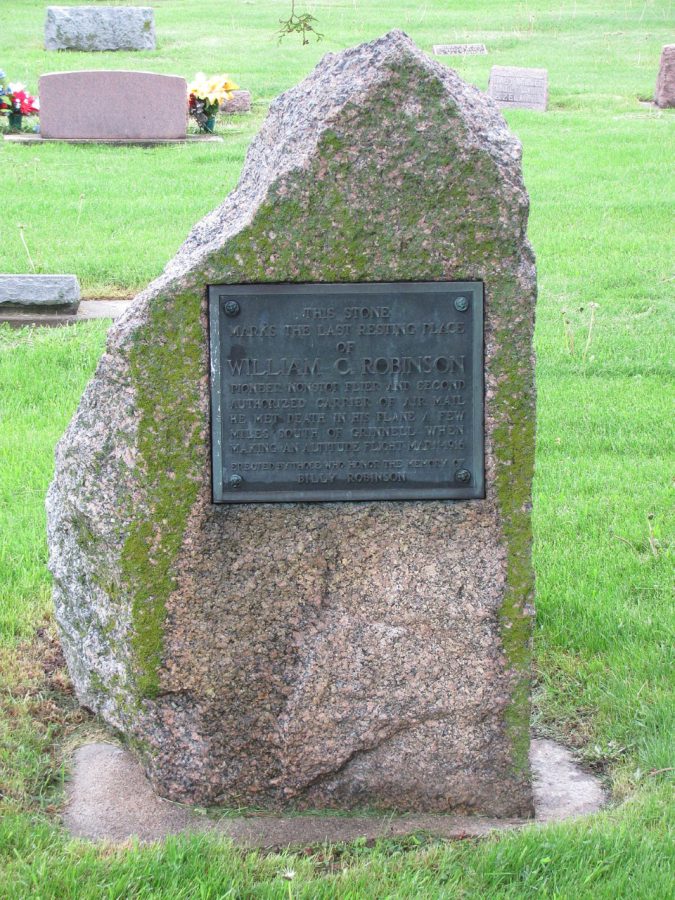From Peace Rock to pieces of rock: Explosive end of the decades-long Class Scrap
The gravestone of Billy Robinson in Hazelwood Cemetery is a piece of Peace Rock.
October 10, 2022
From the 1870s to 1913, Grinnell College was the site of a long-held tradition: the “Class Scrap.” Freshmen and sophomore men participated in a capture-the-flag style wrestling match, seen as a spectacle by even the town’s local news. The competition included camping out in town and kidnapping members of the opposing team for points. The event would usually conclude with a grand final bout that lacked formalized rules or guidelines regarding safety or restraint. However, with many students and staff concerned about the violence, the scrap was put to an end with a boulder called Peace Rock.
But that was only the beginning of Grinnell’s culture war. In the spring of 1914, after being illicitly painted red the week prior, the boulder was blown apart with a large bundle of dynamite on the early morning of April 21. Following weeks of bloodshed and bombing, the rock would find its indefinite resting place when several vandals rolled it into a freshly dug hole. Although the Peace Rock is long gone, archaeologists excavated fragments of the stone in the spring of 2017, and it is still a marker for Grinnell’s cultural history.
Local historian and author Byron Hueftle-Worley led a 2017 excavation of the Peace Rock and has researched its history extensively.
“As one might expect, many people in town, and most certainly the college administration, took a very dim view of such a breach of fair play and decency,” Hueftle-Worley wrote for Volume IV, Issue 2 of Rootstalk 2018.
Several cases of property damage and severely injured students became commonplace during the Campus Scrap. In one case, some students trapped others in a room and one threw bromine through the window. The freshmen became sick and one received severe chemical burns on his arm.
After the death of a student in a similar event at a Wisconsin college, then Grinnell College President John Hanson Thomas Main decided to stop the tradition and, with the agreement of the presidents of the freshman and sophomore class, elected to place a large stone in the center of campus to commemorate the agreement.
The expected Class Scrap was instead replaced by a gathering of men in the first- and second-year classes on a farm hauling a large granite boulder. The stone was pulled in a cart, by hand, back to campus. They unloaded the stone and officially declared the end of the traditional Class Scrap.
“The class scrap returned the next school year in the form of a game of pushball … Some vestiges of the tradition lasted at least until the 1960s with much more restraint,” wrote Hueftle-Worley.
As for the rock itself, after students blew it up with TNT, others took pieces of it and stashed them away around the town of Grinnell. One piece marks the grave of Grinnell alumn Billy Robinson, an aviator who died attempting to break an altitude record. A different fragment of the Peace Rock is located at Long Home, the first house in Grinnell, and another at J. B. Grinnell House, which is named after the founder of the town.
After researching the Peace Rock and its history on campus, Hueftle-Worley requested aid in April 2017 from John Whitaker and Kathy Kamp, two anthropology professors and experienced archaeologists at Grinnell College, in recovering the Peace Rock from its grave. Using photos, yearbooks and ground-penetrating radar, its general location was estimated. As part of a field methods class, the students and professors successfully excavated fragments of the detonated rock from the site. Now, those pieces are located outside Bucksbaum.
Notably, World War I started a few months after the Peace Rock’s burial. Drafting began three years later in 1917, so the same campus that had erected this rocky installation for peace was to experience it for long.
“Most of the male students on campus, along with many of the recent graduates, enlisted in the military,” Hueftle-Wortley wrote. “Many of them served overseas, and some never returned.”
Hueftle-Worley spoke with the S&B about his research and provided information about the Class Scrap and Peace Rock. More information can also be found in Grinnell’s Debate Union documents.



















































